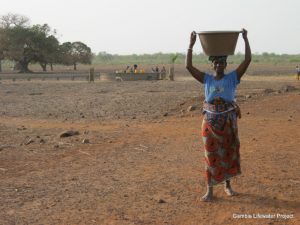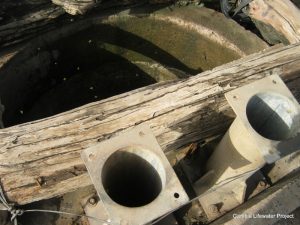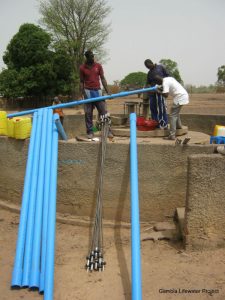This is a large-scale program to undertake a series of projects to:
(1) repair and install hand pumps and (2) to improve water, sanitation, and hygiene conditions in the region.
The initial projects under the program have been, and are continuing to be, carried out under the direction of Returned Peace Corps Volunteer Jeremy Mak. To date, 18 Mark II pumps have been repaired and 3 new Blue Pumps have been installed. This has increased water access for more than 5,000 women, children, and men in 11 villages. (update: now up to 10,000 people in 20 villages!)
The projects previously undertaken are listed below, and the list will be updated as new projects are added:
- Dankunku, Fula Kunda, and Brikama Lefaya Pump Project – The Gambia by Jeremy Mak as a PCV
- Niamina Dankunku Area Pump Project – The Gambia by Jeremy Mak as an RPCV
- Sinchu Jaabo and Kaani Kunda Pump Project – The Gambia by Jeremy Mak as an RPCV
- Choya, Si Kunda, and Kalikajara Pump Project – The Gambia by Jeremy Mak as an RPCV
To see a PowerPoint presentation that Jeremy has prepared to highlight the previous work, CLICK HERE. To date, 23 pumps have been installed or repaired.
Community Description
 This program will focus on the Central River Region, The Gambia, West Africa. The area is very rural. The vast majority of the population is without running water or electricity. Services are either very basic or nonexistent. Transportation is difficult, as the communities are located off the main highway, and none of the roads are paved.
This program will focus on the Central River Region, The Gambia, West Africa. The area is very rural. The vast majority of the population is without running water or electricity. Services are either very basic or nonexistent. Transportation is difficult, as the communities are located off the main highway, and none of the roads are paved.
Most Gambians in the region make their livelihoods through farming coos, peanuts, and rice in the dry season, by tending cattle, and to a smaller extent, fishing. Poverty is manifested in many ways, most prominently not having enough to eat.
Compounded with poor water access and difficulty of growing food in the dry season, malnutrition and sickness are common, as are skin diseases and other infections. Many of the more remote villages in the area are greatly under-served in every respect. Low government and aid penetration has left numerous villagers living a hand-to-mouth existence.
Numerous Mark II hand pumps were installed in the area by the Government of The Gambia and outside aid groups in the 1990’s. However, no formal maintenance or repair program exists to ensure the proper service functioning of these high-maintenance pumps. As a result, many pumps have fallen into disrepair.
Since the majority of villagers do not possess the specialized tools, the technical knowledge, or the funds to maintain or fix pumps, broken pumps are sometimes abandoned. When a pump breaks, women and girls—those traditionally responsible for fetching water—must walk further and further in search of other villages with working pumps.
More often than not, villagers desperate for water will open the hand pump well cover to pull up water with buckets and rope. Removing a covered well compromises the quality and cleanliness of a village’s water supply, as contamination through dirt, runoff, and other pollutants can quickly create a breeding ground for a variety of debilitating and potentially fatal waterborne diseases. These illnesses not only harm the health and wellbeing of villagers, but also impact on the ability of locals to work and earn a living.
More pumps will continue to wear out beyond repair unless immediate replacement parts or improved pumps are installed. No organization is currently working in the area to upgrade handpump infrastructure.

Program Description
The overarching program concept focuses on improving rural clean water access in the Central River Region of The Gambia.
This program seeks to immediately repair broken Mark II pumps, identify villages in need of new Blue Pumps, and undertake a series of related water, sanitation, and hygiene projects.
The Dutch Blue Pumps are stronger than the Mark II, require little to no maintenance, and have a much higher output of water than the Mark II—all resulting in a more reliable water supply and less time collecting water for villagers who solely depend on wells for their water needs.
Although the capacity exists to fix Mark II pumps, the main focus will be to promote and distribute Blue Pumps, as it is often more cost-effective and more sustainable to replace old pumps with Bluepumps rather than repeatedly fixing malfunction-prone Mark II’s.
This Blue Pump technology is donated through the generosity of the Fairwater Foundation, and installed by Swe-Gam, the local Gambian implementing partner equipped and trained to maintain these pumps. Swe-Gam has made an initial offering of 15 Blue Pumps, with possible additional pumps available.
Villages will be identified that have defunct pumps and/or that cannot afford to maintain their Mark II’s, with a special focus on schools and health centers. The team will work with villages to coordinate the delivery and installation of the Blue Pumps.
Special emphasis will be focused on under-served rural villages, particularly traditionally marginalized Fula communities in Niamina East District. The preliminary site list includes the Mount Carmel School in Sofyanama, Fula Kunda, Dankunku Health Center, the Mosque in Kaani Kunda Suba, and Nana.
In addition, assistance will be offered to interested Peace Corps Volunteers who wish to install Blue Pumps in water-stressed villages nearby (i.e. Jimbala in Central River Region—North Bank; St. Therese School in Fula Bantang; and Jarra Sukuta, Lower River Region—South Bank).
While the main thrust of the program will be for pump repair and installation of new pumps, small WASH projects will be undertaken to improve general water distribution, storage, drainage, sanitation, and hygiene.
 Under consideration will be the creation of a series of robust water distribution networks, including storage reservoirs, which will serve to build and test the operational capacity and proficiency of the team to implement future projects.
Under consideration will be the creation of a series of robust water distribution networks, including storage reservoirs, which will serve to build and test the operational capacity and proficiency of the team to implement future projects.
The first of these WASH projects to be implemented is the Brikama Lefaya Water, Sanitation, and Hygiene (WASH) Improvement Project – The Gambia.
Most of the Water Charity funds will be used to pay for costs for Swe-Gam to transport pumps from Banjul, the capital, to remote villages and install them. In addition, the money will pay for masons and other skilled labor, as well as incidental materials costs.
A fraction of the monies will support communication costs and local transportation to survey communities and visit Mark II suppliers in the city, in addition to a food stipend for a two-person team, and a small per diem for a translator. Additionally, a GPS device will be purchased to mark the sites for increased transparency and accountability to donors and the humanitarian water aid sector.
Villagers will contribute cement, sand, and the gravel needed to form a protective concrete base for the pumps.
This is an extremely cost-effective and ambitious program that will have a widespread impact on the health and well-being of a large number of people. It builds upon previous successes and strengthens the framework to expand the effort. It involves great collaboration with other agencies to amplify the benefits that will accrue.
The major funding for this program is coming through the generosity of Child Relief International.
Additional funds are required. To make a contribution for this program, please click the Donate button below. We will be grateful for donations in any amount. Donations of $250 or more will be acknowledged here:
Beverly Rouse, of Glendora, CA, USA, contributed $250
Brian Lee, of Los Angeles, CA , USA, contributed $250
This project has been finished. To read about the conclusion of the project, CLICK HERE.
A 2nd phase of this program has also been enacted and completed as well. To read about Phase 2, CLICK HERE.
Now, a 3rd phase has been enacted and completed as well. To read about Phase 3, CLICK HERE.
All Phases of this wonderful program still need donations to recoup the funds Water Charity used to pre-fund them, so please consider helping us do more projects like this.